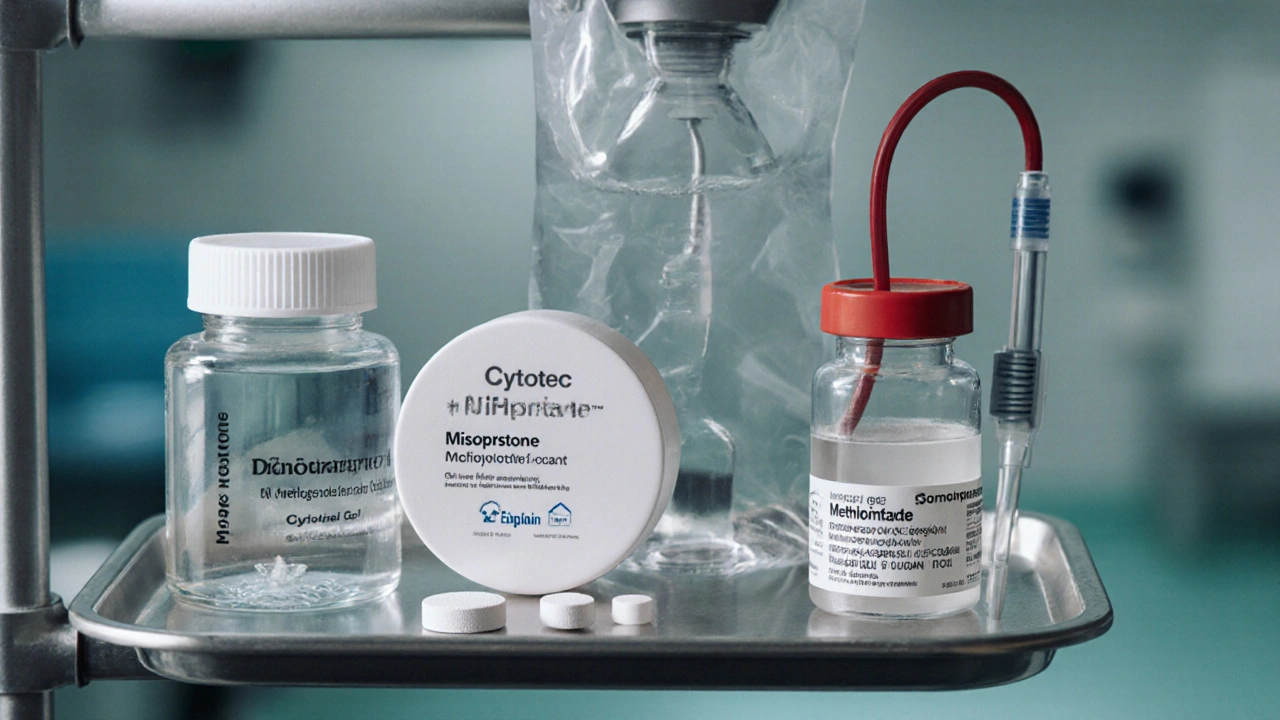When you or a loved one need a drug like Cytotec, the first question is often: “Is there a better option?” Whether you’re dealing with ulcer prevention, labor induction, or medical abortion, knowing how Cytotec stacks up against other medicines can save you money, reduce side effects, and avoid legal hassles.
Key Takeaways
- Misoprostol (Cytotec) is a prostaglandin analog used for ulcers, labor induction, and abortion.
- Common alternatives include Dinoprostone, Mifepristone, Methotrexate, and Oxytocin, each with distinct mechanisms.
- Consider FDA approval status, route of administration, cost, and side‑effect profile when choosing.
- Oral or buccal misoprostol is most affordable but may cause gastrointestinal upset; injectable options can be more controlled.
- Always consult a healthcare professional; self‑medicating can lead to serious complications.
Cytotec is the brand name for misoprostol, a synthetic prostaglandin E1 analog that protects the stomach lining and triggers uterine contractions. FDA approved it in 1988 for preventing NSAID‑induced gastric ulcers, and later off‑label uses expanded to obstetrics and gynecology. The drug comes in 200µg tablets, typically taken orally, sublingually, or vaginally depending on the indication.
Why Look for Alternatives?
Several practical reasons push patients and clinicians toward other drugs:
- Regulatory restrictions: In some U.S. states, prescribing misoprostol for abortion is heavily regulated, limiting access.
- Side‑effect concerns: Nausea, diarrhea, and cramping are common, especially with high oral doses.
- Cost considerations: While generic misoprostol is cheap, insurance coverage may vary, making alternatives more affordable under certain plans.
- Specific clinical scenarios: For cervical ripening before labor, a prostaglandin F2α analog like dinoprostone may be preferred for its predictable onset.
Top Alternatives to Cytotec
Below are the most frequently discussed substitutes, each with its own niche.
Dinoprostone (prostaglandin E2) is FDA‑approved for cervical ripening and induction of labor. It’s available as a vaginal insert, gel, or suppository, delivering a steady dose over several hours.
Mifepristone is a progesterone receptor antagonist used in combination with misoprostol for medical abortion up to 10weeks gestation. It blocks the hormone that maintains pregnancy, making the uterus more responsive to prostaglandins.
Methotrexate is a folate antagonist employed for ectopic pregnancies and early medical abortions when combined with misoprostol. It halts cell division, allowing the gestational tissue to be expelled safely.
Oxytocin is a peptide hormone used intravenously to stimulate uterine contractions during labor or to control postpartum hemorrhage. Unlike misoprostol, it requires continuous IV infusion and a hospital setting.

Side‑by‑Side Comparison
| Attribute | Cytotec (Misoprostol) | Dinoprostone | Mifepristone + Misoprostol | Methotrexate + Misoprostol | Oxytocin |
|---|---|---|---|---|---|
| FDA Approval | Ulcer prevention, off‑label obstetrics | Labor induction (approved) | Medical abortion (approved in combo) | Ectopic pregnancy, off‑label abortion | Labor induction, hemorrhage control |
| Primary Mechanism | Prostaglandin E1 analog - increases uterine tone | Prostaglandin E2 - cervical softening | Progesterone antagonist + prostaglandin | Antimetabolite + prostaglandin | Peptide hormone - stimulates contraction |
| Typical Route | Oral, buccal, sublingual, vaginal tablets | Vaginal insert, gel, suppository | Oral mifepristone (200mg) then buccal/oral misoprostol | IM methotrexate (50mg/m²) then oral misoprostol | IV infusion |
| Onset of Action | 30‑60min (oral); 2‑4h (vaginal) | 2‑4h (insert) | 30‑60min after misoprostol dose | 24‑48h after methotrexate | Immediate (within minutes) |
| Common Side Effects | Nausea, diarrhea, cramping, fever | Uterine hyperstimulation, headache | Bleeding, cramping, nausea | Liver toxicity (rare), stomatitis | Water intoxication, uterine rupture (high dose) |
| Average Cost (US) | $10‑$20 for a pack of 4 tablets | $40‑$70 per insert | Mifepristone $250‑$350; misoprostol $10‑$20 | Methotrexate $30‑$50; misoprostol $10‑$20 | $25‑$40 per vial (hospital‑charged) |
| Best For | Low‑cost ulcer prophylaxis, early abortion, cervical ripening in low‑resource settings | Controlled labor induction in hospital | Standard regimen for elective medical abortion up to 10weeks | Ectopic pregnancy resolution when surgery not preferred | Active labor management or postpartum hemorrhage control |
How to Choose the Right Option
Think of the decision as a checklist. Ask yourself these questions:
- What’s the primary goal? Ulcer prevention, induction of labor, or terminating a pregnancy?
- What setting am I in? Home use, clinic, or hospital?
- Do I have insurance coverage? Some plans cover dinoprostone but not misoprostol for off‑label uses.
- How sensitive am I to side effects? If gastrointestinal upset is a deal‑breaker, consider dinoprostone or oxytocin.
- What legal constraints apply? Certain states restrict misoprostol for abortion; mifepristone may be easier to obtain in a clinic.
Match your answers to the table above. For example, a woman in a state where misoprostol is hard to get might opt for the mifepristone‑misoprostol combo prescribed at a certified clinic. Meanwhile, a patient with chronic NSAID use would likely stick with Cytotec for ulcer protection because it’s the cheapest and proven option.

Practical Tips & Common Pitfalls
- Never combine multiple prostaglandins without a doctor’s order. Overlapping effects can cause uterine hyperstimulation.
- Store tablets properly. Misoprostol degrades with heat and moisture; keep them in a cool, dry place.
- Follow timing precisely. For abortion protocols, the 24‑hour interval between mifepristone and misoprostol is crucial.
- Watch for drug interactions. NSAIDs can blunt misoprostol’s effect; anticoagulants raise bleeding risk.
- Plan for emergency care. Heavy bleeding or severe cramping after any uterotonic therapy warrants immediate medical attention.
Frequently Asked Questions
Is Cytotec safe for home use?
When used for ulcer prevention at the standard 200µg daily dose, Cytotec is generally safe at home. Off‑label uses like labor induction should only be done under medical supervision because dosage and timing are critical.
How does dinoprostone differ from misoprostol?
Dinoprostone (prostaglandin E2) mainly softens the cervix, while misoprostol (prostaglandin E1) actively contracts the uterus. Dinoprostone’s onset is slower but more predictable, making it a preferred hospital choice for induction.
Can I use mifepristone without misoprostol?
Mifepristone alone will cause the uterus to become less receptive to pregnancy, but without misoprostol the tissue may not be expelled fully, leading to incomplete abortion. The combination is the standard, evidence‑based regimen.
What are the cost differences between these drugs?
Generic misoprostol (Cytotec) is the cheapest, typically under $20 for a standard course. Dinoprostone inserts run $40‑$70 each. Mifepristone costs $250‑$350, and methotrexate is about $30‑$50. Insurance coverage can flip these numbers, so check your plan.
Are there any long‑term risks with repeated misoprostol use?
Long‑term use for ulcer prevention is generally well‑tolerated. However, chronic exposure can cause persistent gastrointestinal irritation. For repeated obstetric use, the main concern is uterine scarring, which is rare but should be discussed with a specialist.

Abhinanda Mallick
October 13, 2025 AT 17:11From an Indian perspective the economics of Cytotec cannot be dismissed; a 200 µg tablet costs a fraction of a dinoprostone insert, making it indispensable in low‑resource settings. Yet the regulatory climate in many states forces clinicians to weigh legal risk against clinical benefit, a dilemma seldom discussed abroad. The prostaglandin E1 analog not only shields the gastric mucosa but also provides a reliable uterine contractile force when administered correctly. Its pharmacokinetics allow oral, sublingual, and vaginal routes, granting flexibility that many newer agents lack. When budget constraints dominate, the cheapest yet efficacious option should be preserved, lest we revert to expensive, hospital‑bound therapies. Moreover, the off‑label applications have amassed a robust evidence base, disproving the myth that only FDA‑approved drugs are safe. In the grand tapestry of obstetric care, Cytotec remains a cornerstone, especially where the state apparatus hinders access to alternatives.
Amanda Anderson
October 14, 2025 AT 22:26Honestly, the table does a solid job of breaking down costs and side effects, making it easier for anyone to compare. If you’re looking for a cheap option for ulcer protection, Cytotec is hard to beat. For labor induction in a hospital, dinoprostone’s predictable onset can be a real plus. And yeah, the mifepristone‑misoprostol combo is the gold standard for medical abortion up to ten weeks.
Carys Jones
October 16, 2025 AT 05:00It is ethically indefensible to promote self‑medication with Cytotec when the legal framework expressly limits its use for abortion. The casual dismissal of regulatory restrictions betrays a deep‑seated moral complacency. One must recognize that rampant off‑label use can exacerbate health disparities and erode trust in medical authority. Moreover, glorifying a cheap drug without acknowledging its potential for severe gastrointestinal distress is dangerously naive. The responsible path involves strict physician oversight, not do‑it‑yourself regimens.
Roxanne Porter
October 17, 2025 AT 11:33Thank you for the comprehensive overview. I would add that patient preference should also factor into the decision‑making process, especially when side‑effect profiles differ significantly. Collaborative discussion between clinician and patient often leads to the most satisfactory outcome.
Jonathan Mbulakey
October 18, 2025 AT 18:06Choosing the appropriate uterotonic or ulcer‑preventive agent is not merely a clinical calculation but a philosophical exercise in weighing values. One must first delineate the primary therapeutic goal, whether it be mucosal protection or induction of labor, as this defines the relevant pharmacodynamics. The context of care-home, clinic, or tertiary hospital-introduces constraints on administration routes, and consequently on drug selection. Cost, while often a decisive factor, should be examined against the backdrop of long‑term outcomes and potential downstream expenses from adverse events. Ethical considerations arise when legal restrictions impede access to the most efficacious regimen, compelling clinicians to seek alternatives that may be suboptimal. The clinician’s duty, therefore, extends beyond prescribing to navigating the labyrinth of insurance coverage, regional legislation, and patient autonomy. In practice, Cytotec’s affordability makes it an attractive first‑line agent for ulcer prophylaxis, yet its off‑label uses demand rigorous monitoring. Dinoprostone, with its slower onset, offers a controlled labor induction that aligns with hospital protocols, reducing the risk of hyperstimulation. Mifepristone paired with misoprostol epitomizes evidence‑based medical abortion, but the need for sequential dosing imposes logistical challenges. Methotrexate, while effective for ectopic pregnancies, introduces systemic toxicity that must be balanced against surgical alternatives. Oxytocin, as an infusion, provides immediate uterine contractility but requires continuous supervision, limiting its utility outside inpatient settings. Ultimately, the physician must synthesize these variables-clinical indication, setting, regulatory environment, cost, and patient values-into a coherent, individualized treatment plan that honors both efficacy and safety.
Warren Neufeld
October 20, 2025 AT 00:40I understand the anxiety many feel when facing medication choices. It helps to talk with a healthcare provider about how each drug’s side‑effects might affect you personally. Simple steps like storing misoprostol in a cool, dry place can preserve its potency.
Deborah Escobedo
October 21, 2025 AT 07:13For anyone weighing options, remember that the cheapest drug isn’t always the best fit for your unique situation. Consider the route of administration, the setting you’ll be in, and any insurance coverage you have. A brief chat with your doctor can clarify these points and guide you toward the safest, most effective choice.
Dipankar Kumar Mitra
October 22, 2025 AT 13:46Life throws us choices like a deck of cards; you can either accept the hand you’re dealt or bluff your way to a better deal. Cytotec’s low price is seductive, but don’t be fooled-its side‑effects can gnaw at you like an unseen parasite. If you crave control, the hospital‑grade dinoprostone or oxytocin might feel more respectable, even if they cost more. In the end, the decision reflects how deeply you’re willing to sacrifice comfort for certainty.
Patrick Nguyen
October 23, 2025 AT 20:20Cost alone should not dictate drug selection.
Patrick Bread
October 25, 2025 AT 02:53Ah yes, because ignoring the price tag solves all the regulatory and clinical nuances – truly a masterstroke of simplistic reasoning.